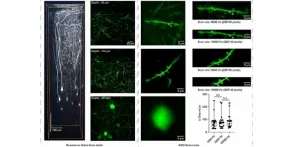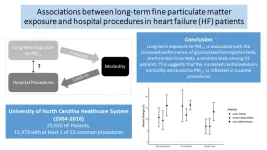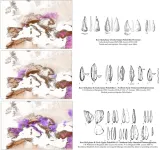(Press-News.org) Two-photon microscopy (TPM) has revolutionized the field of biology by enabling researchers to observe complex biological processes in living tissues at high resolution. In contrast to traditional fluorescence microscopy techniques, TPM makes use of low-energy photons to excite fluorescent molecules for observation. This, in turn, makes it possible to penetrate the tissue much more deeply, and ensures that the fluorescent molecules, or fluorophores, are not permanently damaged by the excitation laser.
However, some biological processes are simply too fast to be recorded, even with state-of-the-art TPMs. One of the design parameters that limits the performance of a TPM is the line scanning frequency, measured as frames per second (FPS). This refers to the rate at which the target sample can be swept across by the excitation laser along one direction (for instance, in a horizontal sweep). A slow scanning frequency also impacts the overall FPS of the system, since it determines how fast the laser can be swept across the other direction, i.e. in a vertical sweep. Together, these create a tradeoff between the microscope’s temporal resolution and the size of the observation frame.
Working around this problem, an international team of researchers from China and Germany recently developed a powerful TPM setup with an unprecedentedly high line scanning frequency. According to their report published in Neurophotonics, this microscopy system was designed for imaging fast biological processes at a high temporal as well as spatial resolution.
One of the key factors that distinguish the proposed TPM from the conventional ones is the use of acousto-optic deflectors (AODs) to control the scanning of the excitation laser. An AOD is a special type of crystal whose refractive index can be precisely controlled by acoustic waves. This, in turn, allows us to redirect a laser beam through it as desired. More importantly, AODs enable a faster laser-steering than that obtained with the galvanometers used in conventional TPMs.
Accordingly, the team designed a custom AOD with an exceptionally high acoustic velocity using a tellurium dioxide (TeO2) crystal, achieving a high line scanning frequency. With this AOD, the laser could scan a line in the frame within a mere 2.5 microseconds, corresponding to a maximum line scanning frequency of 400 kHz. Similarly, the team used an AOD to achieve a reasonable slow scanning frequency in the other direction.
To further improve the adaptability of their microscope, the team added the option of switching to a galvanometer-based laser scanning mechanism when necessary. This allowed the scanning of large regions of the sample at an acceptable resolution and speed, making it easier to locate small areas of interest before switching to AOD scanning.
The team conducted several proof-of-concept experiments with the newly designed TPM. They installed cranial windows on genetically engineered mice and used them to observe the morphology and activity of neurons as well as the movement of single red blood cells (RBCs). The system achieved a frame rate of up to 10,000 FPS using an appropriate AOD configuration and frame size. This was sufficient to precisely measure the velocity at which calcium propagates in neuronal dendrites as well as to visualize the trajectory of individual RBCs within blood vessels.
Impressed by these results, Dr. Na Ji, Associate Editor of Neurophotonics and Luis Alvarez Memorial Chair in Experimental Physics at UC Berkeley, remarks, “The new system for AOD-based scanning microscopy represents a substantial improvement in imaging speed and performance, as demonstrated in its application for calcium signal propagation and blood flow measurements in the brain in vivo.”
Going forward, the new proof-of-concept TPM design will make it possible to capture fast biological processes, and could significantly improve our understanding of them.
Read the Gold Open Access article by Li et al., “Ten-kilohertz two-photon microscopy imaging of single-cell dendritic activity and hemodynamics in vivo,” Neurophotonics 10(2), 025006 (2023), doi 10.1117/1.NPh.10.2.025006.
END
New high-speed, two-photon microscope for precise biological imaging
Innovative laser scanning design unlocks high-precision observations at up to 10,000 frames per second, making the microscope a powerful recording tool
2023-05-03
ELSE PRESS RELEASES FROM THIS DATE:
May issues of American Psychiatric Association journals cover new treatments, assessing crisis lines, suicide prevention, and more
2023-05-03
The latest issues of three of the American Psychiatric Association’s journals, The American Journal of Psychiatry, Psychiatric Services and Focus are now available online.
The May issue of The American Journal of Psychiatry focuses on treatments, with articles presenting issues related to psychedelics, trichotillomania, social anxiety disorder, schizophrenia, and opioid use disorder. Highlights include:
Psychedelics as Transformative Therapeutics.
Double-Blind Placebo-Controlled Study of Memantine in Trichotillomania and Skin-Picking Disorder.
Attention Bias Modification Treatment Versus a Selective ...
Particulate matter linked to increased hospital procedures in heart failure patients
2023-05-03
Long-term exposure to fine particulate matter air pollution was associated with an increase in hospital procedures in heart failure patients, according to a study published May 3, 2023, in the open-access journal PLOS ONE by Samantha Catalano from the University of North Carolina at Chapel Hill, USA, and colleagues.
Tiny airborne particles smaller than 2.5μm in diameter (PM2.5) are air pollutants generated by traffic, industry activity, combustion, and more. Though exposure to PM2.5 has been associated with illness and death worldwide, ...
Stone tools reflect three waves of migration of the earliest Sapiens into Europe
2023-05-03
The first modern humans spread across Europe in three waves during the Paleolithic, according to a study published May 3, 2023 in the open-access journal PLOS ONE by Ludovic Slimak of the CNRS and University of Toulouse III, France.
The archaeological record of Paleolithic Europe leaves many open questions regarding the nature of the arrival of modern humans into the region and the nature of how these newcomers interacted with the resident Neanderthal populations. In this study, Slimak compared records of stone tool technology across western Eurasia to document the sequence of early human activity in the region.
This study primarily focused on ...
For immigrants with limited education, the personality traits of extraversion and openness significantly boost lifetime employment probabilities, likely by facilitating better integration
2023-05-03
For immigrants with limited education, the personality traits of extraversion and openness significantly boost lifetime employment probabilities, likely by facilitating better integration
###
Article URL: https://journals.plos.org/plosone/article?id=10.1371/journal.pone.0281048
Article Title: Non-cognitive skills and labour market performance of immigrants
Author Countries: Germany, Türkiye
Funding: We appreciate the financial support from the University of Gothenburg”. The funders had no ...
Reading detailed information about artworks leads to psychophysiological and behavioral changes
2023-05-03
Visitors to a modern art museum lingered in front of artworks longer and exhibited more signs of excitement when given detailed descriptions of each piece compared to seeing basic labels, according to a study published May 3, 2023 in the open-access journal PLOS ONE by Serena Castellotti from the University of Florence, Italy, and colleagues.
Improving the cultural and aesthetic experience of non-expert visitors is a critical task for art museums. In this study, the authors examined how museum-provided descriptions of art might influence a visitor’s ...
Packaged foods marketed to kids are significantly higher in sugar and lower in other nutrients than other products, according to Canadian study of almost 6,000 items
2023-05-03
Packaged foods marketed to kids are significantly higher in sugar and lower in other nutrients than other products, according to Canadian study of almost 6,000 items
###
Article URL: https://journals.plos.org/plosone/article?id=10.1371/journal.pone.0284350
Article Title: Child-appealing packaged food and beverage products in Canada–Prevalence, power, and nutritional quality
Author Countries: Canada
Funding: This study was funded by the Canadian Institutes of Health Research Frederick Banting and Charles Best Doctoral ...
Electric vehicles may mostly decrease pollution in richer, whiter neighborhoods, with less benefit for disadvantaged communities, per analysis of California's Clean Vehicle Rebate Project
2023-05-03
Electric vehicles may mostly decrease pollution in richer, whiter neighborhoods, with less benefit for disadvantaged communities, per analysis of California's Clean Vehicle Rebate Project.
####
Article URL: https://journals.plos.org/climate/article?id=10.1371/journal.pclm.0000183
Article Title: Emissions redistribution and environmental justice implications of California’s clean vehicle rebate project
Author Countries: USA
Funding: Funding was provided through the SURGE Research Fellowship, Stanford University School of Earth, Energy & Environmental Sciences (JMD). The funders had no role in study design, data collection and analysis, decision to publish, ...
Bloodstream infections in preemies may originate from their gut microbiomes
2023-05-03
Dangerous bacterial bloodstream infections in preemies may originate from the infants’ gut microbiomes, according to researchers at Washington University School of Medicine in St. Louis. Such infections are of substantial concern, as about half of infants who are extremely preterm or have very low birth weights experience at least one episode of the life-threatening infection after 72 hours of life.
The findings are published May 3 in the journal Science Translational Medicine.
Preterm infants are at high risk of infections due to underdeveloped organs, coupled with considerable antimicrobial exposure. ...
Breakthrough for sweat: health monitoring device from UH researchers
2023-05-03
Link to video and sound (details below): https://go.hawaii.edu/qRX
Sweat is more than just a sign of a good workout. It holds vital information about our health, providing clues to dehydration, fatigue, blood sugar levels and even serious conditions such as cystic fibrosis, diabetes and heart failure. Researchers at the University of Hawaiʻi at Mānoa College of Engineering have taken a giant leap forward in sweat analysis with an innovative 3D-printed wearable sweat sensor called the “sweatainer.”
Harnessing the power of additive manufacturing (3D-printing), the researchers have developed ...
Studying fundamentals of water as a solvent could lead to greener cellulose-based products
2023-05-03
Water isn’t just a universal solvent that remains unaffected by its interactions. New publications from North Carolina State University show that water can change its solubility characteristics depending upon what it interacts with. Specifically, when water interacts with cellulose, it can stack in layered shells to control chemical reactions within, and physical properties of, the material. The work has implications for more sustainable and efficient design of cellulose-based products.
“Cellulose is the world’s most abundant biopolymer, and it’s used in applications ...
LAST 30 PRESS RELEASES:
First Editorial of 2026: Resisting AI slop
Joint ground- and space-based observations reveal Saturn-mass rogue planet
Inheritable genetic variant offers protection against blood cancer risk and progression
Pigs settled Pacific islands alongside early human voyagers
A Coral reef’s daily pulse reshapes microbes in surrounding waters
EAST Tokamak experiments exceed plasma density limit, offering new approach to fusion ignition
Groundbreaking discovery reveals Africa’s oldest cremation pyre and complex ritual practices
First breathing ‘lung-on-chip’ developed using genetically identical cells
How people moved pigs across the Pacific
Interaction of climate change and human activity and its impact on plant diversity in Qinghai-Tibet plateau
From addressing uncertainty to national strategy: an interpretation of Professor Lim Siong Guan’s views
Clinical trials on AI language model use in digestive healthcare
Scientists improve robotic visual–inertial trajectory localization accuracy using cross-modal interaction and selection techniques
Correlation between cancer cachexia and immune-related adverse events in HCC
Human adipose tissue: a new source for functional organoids
Metro lines double as freight highways during off-peak hours, Beijing study shows
Biomedical functions and applications of nanomaterials in tumor diagnosis and treatment: perspectives from ophthalmic oncology
3D imaging unveils how passivation improves perovskite solar cell performance
Enriching framework Al sites in 8-membered rings of Cu-SSZ-39 zeolite to enhance low-temperature ammonia selective catalytic reduction performance
AI-powered RNA drug development: a new frontier in therapeutics
Decoupling the HOR enhancement on PtRu: Dynamically matching interfacial water to reaction coordinates
Sulfur isn’t poisonous when it synergistically acts with phosphine in olefins hydroformylation
URI researchers uncover molecular mechanisms behind speciation in corals
Chitin based carbon aerogel offers a cleaner way to store thermal energy
Tracing hidden sources of nitrate pollution in rapidly changing rural urban landscapes
Viruses on plastic pollution may quietly accelerate the spread of antibiotic resistance
Three UH Rainbow Babies & Children’s faculty elected to prestigious American Pediatric Society
Tunnel resilience models unveiled to aid post-earthquake recovery
Satellite communication systems: the future of 5G/6G connectivity
Space computing power networks: a new frontier for satellite technologies
[Press-News.org] New high-speed, two-photon microscope for precise biological imagingInnovative laser scanning design unlocks high-precision observations at up to 10,000 frames per second, making the microscope a powerful recording tool







